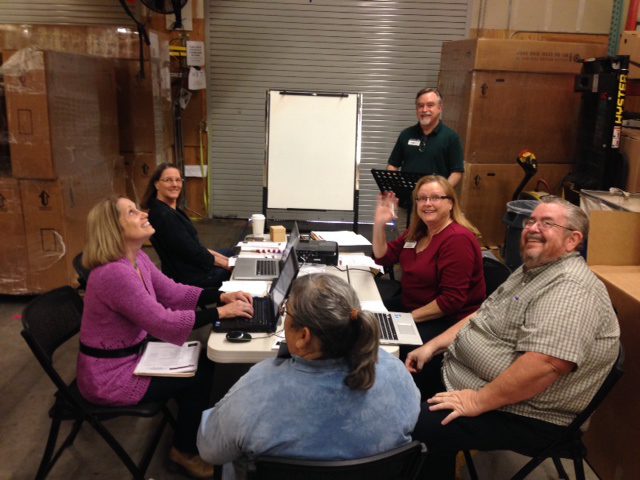A Checklist for Your Next Warehouse Operations Meeting

 Love ’em or hate ’em, we all agree that meetings are a necessary part of doing business. In addition to getting a shared understanding on subjects, meetings also allow for productive idea generation, team collaboration and task assignments.
Love ’em or hate ’em, we all agree that meetings are a necessary part of doing business. In addition to getting a shared understanding on subjects, meetings also allow for productive idea generation, team collaboration and task assignments.
The good news is that meetings can be more productive, fun and highly effective if you follow a few simple guidelines. Below is a list of best practices to follow during your meeting setup. Give them a look and try out the checklist for your next meeting.
Purpose
- Is the meeting necessary? If the meeting didn’t happen, would the business suffer? Would anyone even notice? Many meetings start out as a good idea, but when times change and the meeting is no longer necessary, nobody kills the meeting. So before you do anything else, ask this question: Is this meeting necessary?
- What is the stated purpose of the meeting? Even if it is a weekly check in meeting, it should have that stated in the agenda. Can you tighten the focus of the meeting? Think about what you want to get done in the meeting, and then build your stated purpose around that.
- Have you assigned action items from the meeting to specific people? This is where most meetings fail. Successful companies are action-oriented, and before the meeting is over, a person is named (in the room) that will own the completion of whatever task(s) comes out of the meeting.
Agenda
- Are you ready to share the good, the bad, and the Ugly? If you’re running the meeting, balance what you’re sharing with both inspiration and reality.
- Are you leaving times for stories and fun? While meetings need to be short and effective, they also need to have room for storytelling and spontaneous conversation.For many teams, desk work consumes the day, and meeting time is the only time that community and fun can be expected.
- Have you incorporated emphasis of your mission/vision/values into the meeting? A good practice is to assign a person to report on where they saw the mission/values at work. For example: “This week, I saw our core value of _________ modeled by __________ when ___________ happened.” It’s a very small time investment with a huge return on culture and morale. Company values are hammered home through repetition and story.
- Meetings should talk big picture and small picture? Drive back to the big picture of what your organization is trying to accomplish. Not talking about the long-term vision and goals of the company is a wasted meeting. But, effective meetings also identify the key “urgent and important” items that need to be dealt with by the whole group.
- Do you have room for brainstorming (and guidelines for brainstorming)? Leverage the creative power of the group. Brainstorming is not to be confused with problem-solving. Brainstorming is free form thinking about a problem, with no answer being “wrong.” Be sure to outline guidelines for the brainstorming to prevent it from being ineffective or prevent any one person from dominating the brainstorming time.
- Have you scheduled time to follow up on the previous meeting? When decisions are made at a meeting and tasks assigned to a specific person, there should be a report on what has happened at the next meeting.
Time
- Have you defined a start and finish time? So much of having a great meeting is about respecting people’s time. Consistently treat your people’s time well, and your meetings will become more effective.
- Can you finish the meeting in less time? Most meetings can go quicker than you would expect. Meetings are like a gas, filling whatever size container you give them.
- Keep meetings less than 90 minutes? If you haven’t accomplished your stated meeting purpose in 90 minutes of meeting time, it likely won’t get done. True, there are some meetings that take a long time. But the vast majority of them should be under 90 minutes. The old saying is true: “The mind will only tolerate what the seat can endure.”
Miscellaneous Pointers
- Can you cut the attendee list? One of the biggest complaints about meetings is, “I’m not sure why I have to be there.” Often, you can up your meeting’s effectiveness and efficiency by shrinking the room.
- Do you really need technology at the meeting? When brainstorming or planning, use a whiteboard.
- Is there a note taker? While not everyone needs a computer in the meeting, always assign someone the task of recording what was discussed and decided, with some level of details underneath. But don’t get too detailed. People who feel that their exact words are being recorded are usually less creative than those who feel free to speak.
The Actionable Checklist for Your Next Warehouse Operations Meeting
_____ Is the meeting necessary?
_____ What is the stated purpose of the meeting?
_____ Have you assigned action items from the meeting to specific people?
_____ Have you defined a start and finish time?
_____ Can you finish the meeting in half the allotted time?
_____ Can you agree not to go over 90 minutes?
_____ Are you ready to share the good, the bad, & the ugly?
_____ Are you leaving times for stories and fun?
_____ Have you incorporated emphasis of your mission/vision/values?
_____ Have you scheduled time to talk big picture and small picture?
_____ Do you have room for brainstorming & guidelines for brainstorming?
_____ Have you scheduled time to follow up on the previous meeting?
_____ Can you cut the invite list?
_____ Do you really need technology at the meeting?
_____ Is there a note taker?
Adapted with permission from Vanderbloemen Search Group.
